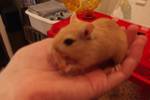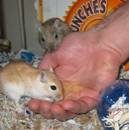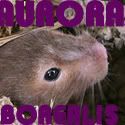U is for untamed... what to do?!
Twin Squeaks, again, has a great article on this.
↓
↓
↓
↓
--------------------------------------------
Hand-tame Your Gerbils


It takes patience to help a gerbil gain this much trust.Start Slowly
The key to taming a gerbil is to take things SLOOOOOWWWWWLY. Many people are discouraged that some gerbils are skittish when they first come home. However, once you earn their trust, gerbils are among the tamest rodent pets. In this tip, we look at three ways you can start to earn your gerbils' trust.
Three Taming Tips
Method #1: Take your time. Put your hand in the tank, palm down, for 2-5 minutes at a time. Do not attempt to pet or pick up your gerbils. Let them sniff, crawl on, and explore your hand. If one of your gerbils nibbles your hand, it is probably out of simple curiousity. Don't jerk your hand away. Instead, blow a quick puff of air at your gerbil's face and say,
NO.Each time your gerbil nips, blow a puff of air. Soon, your gerbil will learn that hands are not something to put in his mouth.
After your gerbils have been comfortable crawling on your hand for several days, you may try slowly lifting your hand about an inch off the ground. Then slowly lower your hand back down. Once your gerbil is comfortable with this movement for several days, you may start to gradually lift your gerbil higher.

Nathan's Peek and Trixie learn to trust him as they eat out of his hand.Method #2: Put a pile of food in your hand and carefully place your hand on the floor of the tank. Let your gerbils come to see your hand as a giant food dish. Do not attempt to lift your hand. Simply let your gerbils sit next to or on your hand, rummage through the assorted seeds and treats, and have a snack. This teaches them to trust you and to associate your hand with good things.
Once again, if a gerbil nips your hand, blow a quick, gentle puff of air and say,
NO.
Method #3: Create a play area for your gerbils. Many people have found that letting gerbils play in a dry bathtub or in a homemade playpen (with supervision) a few times a week helps tremendously with taming. You might fill a large plastic tub with bedding and toys so your gerbils learn that you take them to fun places. 




.jpg)
































.jpg)
.jpg)
.jpg)
.jpg)
.jpg)

















